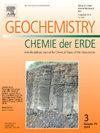Enhanced analysis of hydrothermal alteration and mineral prospecting through integration of ASTER and aeroradiometric data: A case study from the Ouarzazate region, Morocco
IF 2.9
3区 地球科学
Q2 GEOCHEMISTRY & GEOPHYSICS
引用次数: 0
Abstract
The study area, situated in the western segment of the Saghro Massif within the Anti-Atlas belt, is characterized by mineralized deposits, intricate lithological formations, and distinctive tectonic features. This research integrates ASTER imagery analysis with gamma-ray spectrometry data to map alteration zones and examine the geochemical and mineralogical processes that influence radioactive element distribution. Specific analytical techniques are applied to investigate relationships among argillic, phyllic, propylitic alterations, iron oxides, and regions with elevated concentrations of radiometric elements. Gamma-ray spectrometry data, including mono-elemental maps of radiometric components (potassium in %, equivalent uranium in ppm, and equivalent thorium in ppm), are analyzed alongside interpreted ASTER images to identify potential mineralization zones. Ratios of K/eU and K/eTh, along with the F parameter, are processed within a fuzzy model framework, which combines these datasets into a comprehensive mineral prospectivity map that serves as a tool for guiding exploration. This analysis identifies four hydrothermal alteration zones as highly promising for mineral exploration, suggesting a likely association between magmatic processes and spatially correlated hydrothermal alteration, thereby supporting further detailed exploration initiatives.
结合ASTER和航空辐射数据加强热液蚀变分析和找矿:以摩洛哥瓦尔扎扎特地区为例
研究区位于反阿特拉斯带内的萨格罗地块西段,矿床成矿,岩性构造复杂,构造特征鲜明。该研究将ASTER图像分析与伽马射线能谱数据相结合,绘制蚀变带,并检查影响放射性元素分布的地球化学和矿物学过程。特定的分析技术被应用于研究胶、叶基、丙基变化、氧化铁和辐射元素浓度升高区域之间的关系。伽马射线能谱数据,包括辐射成分的单元素图(钾%,当量铀ppm,当量钍ppm),与解释的ASTER图像一起进行分析,以确定潜在的矿化带。K/eU和K/eTh的比率以及F参数在模糊模型框架内进行处理,该模型框架将这些数据集组合成综合的矿产远景图,作为指导勘探的工具。该分析确定了四个极具矿产勘探前景的热液蚀变带,表明岩浆过程与空间相关性热液蚀变之间可能存在关联,从而支持进一步详细的勘探活动。
本文章由计算机程序翻译,如有差异,请以英文原文为准。
求助全文
约1分钟内获得全文
求助全文
来源期刊

Chemie Der Erde-Geochemistry
地学-地球化学与地球物理
CiteScore
7.10
自引率
0.00%
发文量
40
审稿时长
3.0 months
期刊介绍:
GEOCHEMISTRY was founded as Chemie der Erde 1914 in Jena, and, hence, is one of the oldest journals for geochemistry-related topics.
GEOCHEMISTRY (formerly Chemie der Erde / Geochemistry) publishes original research papers, short communications, reviews of selected topics, and high-class invited review articles addressed at broad geosciences audience. Publications dealing with interdisciplinary questions are particularly welcome. Young scientists are especially encouraged to submit their work. Contributions will be published exclusively in English. The journal, through very personalized consultation and its worldwide distribution, offers entry into the world of international scientific communication, and promotes interdisciplinary discussion on chemical problems in a broad spectrum of geosciences.
The following topics are covered by the expertise of the members of the editorial board (see below):
-cosmochemistry, meteoritics-
igneous, metamorphic, and sedimentary petrology-
volcanology-
low & high temperature geochemistry-
experimental - theoretical - field related studies-
mineralogy - crystallography-
environmental geosciences-
archaeometry
 求助内容:
求助内容: 应助结果提醒方式:
应助结果提醒方式:


